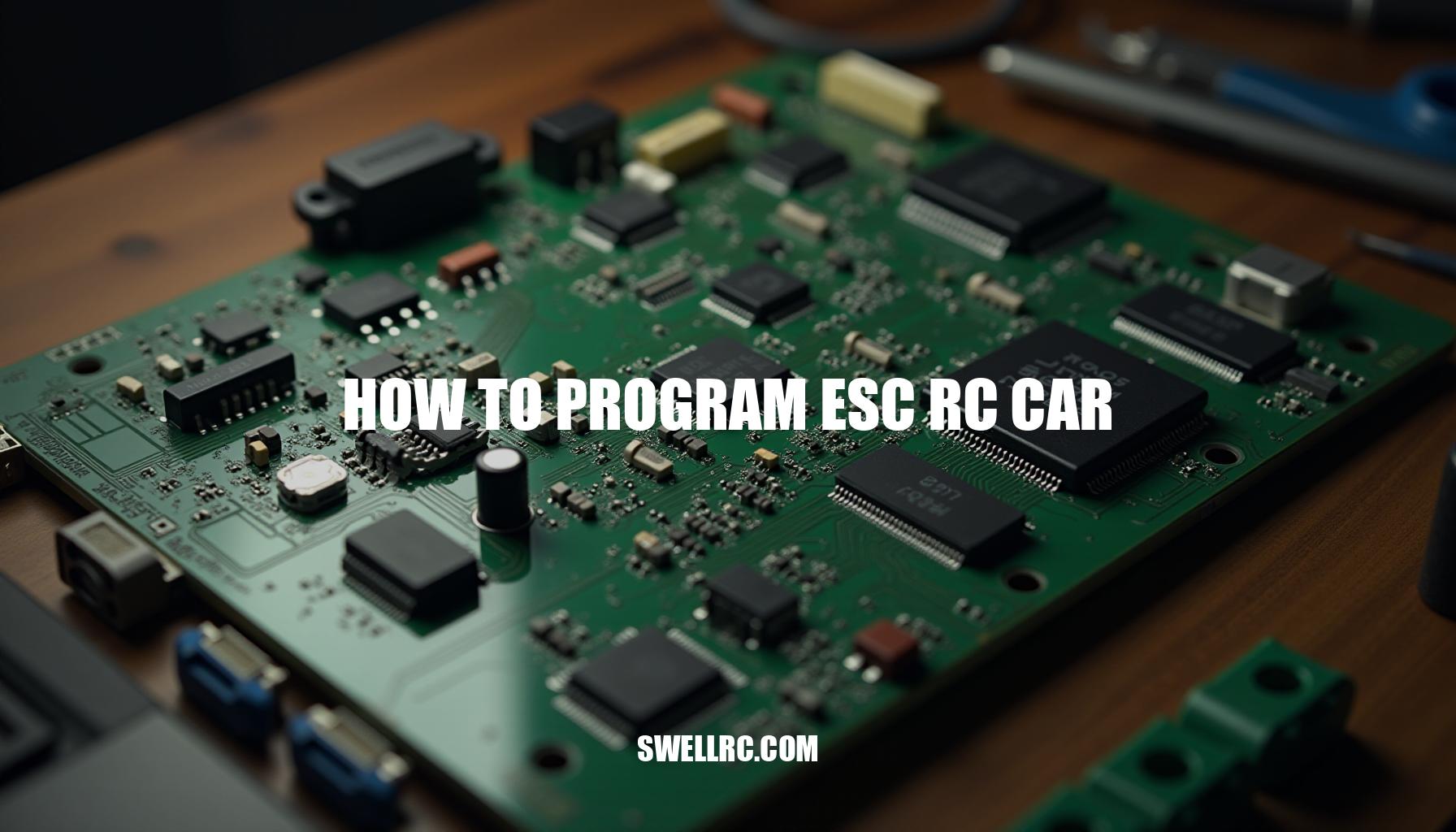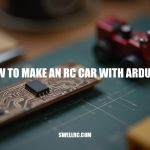How to Program ESC RC Car: Mastering Electronic Speed Controller Setup
The first time I tried to figure out how to program ESC RC car, I was convinced my motor was weak. Nope—the ESC was just miscalibrated. After a weekend of tinkering with RC ESC programming, proper throttle endpoints and braking curves turned the car from jittery to razor‑smooth.
That’s when I realized how central the electronic speed controller really is to feel, torque delivery, and control. If you’re new to electronic speed controller setup, start here: what an electronic speed controller is and why it matters (https://www.swellrc.com/electronic-speed-controller-for-rc-car/).
In this guide, I’ll share the exact setup, programming, troubleshooting, and fine‑tuning steps that made the biggest difference for me—grounded in hands‑on tests and solid ESC fundamentals. Proper ESC calibration ensures your car tracks straighter, brakes smarter, and puts power down without drama.
We’ll also connect the dots across your RC car electronics so each change you make makes sense in the bigger picture, helping you master your setup from start to finish.
Understanding What an ESC Does and Why Programming Matters
Think of the ESC like a super-precise faucet for electricity—it meters power from your battery to the motor based on throttle commands. Programming it tells the faucet how fast and how smoothly to open or close, which is essential in RC vehicle motor tuning. For a deeper dive into switching, PWM, and control logic, see how an electronic speed controller works.
The ESC also must match your motor tech and specs; RC motor ESC compatibility covers brushless vs brushed, sensored vs sensorless, KV/turns, and current ratings—all crucial for performance and longevity. If you’re unsure, this primer on understanding RC electric motors is invaluable.
Signal flow at a glance:
- Throttle position on your radio → transmitter sends PWM/AFHDS/2.4GHz signal
- Receiver outputs a throttle PWM/SR signal → ESC reads pulse width/frames
- ESC modulates battery voltage/current (power modulation) → motor responds with torque and RPM
Some important myths I’ve busted while testing what does an ESC do in an RC car setups:
- “All ESCs are pre‑programmed correctly.” Factory defaults are safe, not optimized; careful ESC calibration is key.
- “One setting fits every track.” Temperature, surface, tires, and gearing change optimal ESC parameters.
- “Programming cards are mandatory.” Helpful, yes—but you can program many ESCs via the transmitter or button beeps.
Preparing Before Programming: Tools, Equipment, and Connections
Before you touch any setting on your RC car electronics, it’s essential to get the basics squared away to ensure a smooth electronic speed controller setup. Here’s my pre-flight checklist to help with throttle calibration RC car and overall ESC programming:
- Radio transmitter with fresh batteries, receiver, ESC, and motor installed properly.
- Correct motor type matched to your ESC, whether brushed or brushless, including a sensored cable if needed.
- Battery chosen within the ESC’s supported cell count and C-rating.
- Programming method prepared: this could be via transmitter/beep sounds, programming card, or PC link for ESC programming methods.
- User manual handy to reference brand-specific beep codes and sequences.
- Solder joints and connectors solid; ensure wheels are lifted or the pinion is removed for safety during setup.
For connections and binding, follow this wiring guide to connect your RC speed controller cleanly. If your radio isn’t bound yet, sync it first to prevent calibration headaches by following this binding tutorial. This is crucial for accurate transmitter calibration and avoids common electronic glitches.
When working with RC car electronics, always prioritize safety. Double-check polarity before powering up—reverse polarity can instantly damage an ESC. Additionally, allow electronics to cool between tests as early overheating can mask actual tuning improvements.
Keep in mind that brand differences exist (Traxxas, Hobbywing, Castle, etc.), affecting the sequence to enter programming mode and menu names. However, the fundamental principles remain universal: calibrate endpoints, define throttle and brake behavior, and set cutoffs. Proper electronic speed controller setup and methodical ESC programming methods ensure optimal performance and longevity of your RC car.
Step-by-Step Guide: How to Program an ESC on an RC Car
Learning how to program ESC RC car without a card involves a manual transmitter-based method compatible with many ESCs. Start by preparing your setup: set the radio throttle EPA/endpoints to 100%, trims to zero, throttle channel normal (or reverse if required by your brand), and expo off. For safety, lift the car or remove the pinion.
- Enter calibration: Hold the ESC’s set/program button while powering on until you hear or see the calibration prompt.
- Full throttle: Pull full trigger and wait for confirmation beeps or flashes.
- Full brake/reverse: Push full brake and wait for confirmation.
- Neutral: Release to neutral; ESC stores endpoints and arms.
- Enter programming: Re-enter program mode via the button or a specific stick sequence. Navigate through beeps to adjust parameters such as brake strength (ESC brake setting adjustment), drag brake, punch, timing, and LiPo cutoff. Save and reboot.
Alternatively, using an RC car ESC programming card or PC link streamlines the setup:
- Power down the ESC and connect its programming lead to the card or USB adapter.
- Power the ESC per manual instructions and use the menu for precise parameter settings—this is excellent for repeatability.
- Write your settings, power cycle the ESC, and then re-arm it.
For example, if you are using Traxxas products, refer to Traxxas ESC settings as a helpful baseline. Also, general how to set up an RC speed controller guides provide great context and best practices.
| Example Tuning Paths | Settings |
|---|---|
| Racing | Lower drag brake (0–5%), moderate punch, increased timing for top-end speed, strong active brake (60–80%) |
| Crawling/Trail | Higher drag brake (50–100%), soft punch for control, low timing for torque and thermal management, gentle brake (20–40%) |
Troubleshooting during programming:
- ESC won’t arm: Throttle is likely reversed; flip the channel direction and perform throttle calibration RC car again.
- No beep prompts: Battery LVC (Low Voltage Cutoff) may have tripped or the BEC/receiver isn’t powered—try a fully charged battery pack and verify all plugs.
- Motor stutters: Could signal wrong timing or sensor cable issues; attempt default timing and reseat or replace the sensor lead.
Advanced Settings and Fine-Tuning Performance
Once your RC vehicle motor tuning achieves a reliable and clean driving experience, fine-tuning these key settings will make your car feel truly “dialed.” Experiment with the following parameters to optimize performance:
- Drag brake: This setting applies braking at neutral throttle. Use a higher drag brake value for crawling to maintain control, and lower settings for racing to keep rolling speed smooth.
- Punch/Current limit: Controls the initial torque to tame wheelspin and protect your drivetrain by limiting the power blast on launch.
- Timing/Boost/Turbo (brushless motors): Adjusts ESC timing advance to increase RPM ranges. However, be cautious with this setting, monitoring temperature levels and gearing conservatively to avoid overheating.
- PWM/brake frequency: Changing pulse-width modulation frequency can modify brake feel, ranging from grabby to more progressive braking characteristics.
- LiPo cutoff: Set your ESC’s LiPo cut-off voltage per cell, typically between 3.2–3.4 V/cell, to protect battery longevity without sacrificing performance.
- BEC voltage: Ensure this matches your servo’s voltage requirements to avoid overdriving components or causing brownouts during demanding steering inputs.
Since electronics interact closely, pairing a strong, fast steering servo with a weak BEC can cause system brownouts and glitches. For detailed advice, consult the servo guide. For hobbyists enjoying custom electronics, learning how to make or evaluate an RC car circuit board will hone your troubleshooting skills significantly.
| Setting | Standard (Bashing) | Custom (Race) |
|---|---|---|
| Punch Control | Conservative punch to reduce wheelspin | Tailored punch based on traction conditions |
| ESC Timing Advance | Low timing for cooler temps | Increased timing for higher RPM, monitor heat |
| Drag Brake | Mid-level brake strength for balanced control | Brake tuned to track grip for precise cornering |
| PWM Brake Frequency | Default frequency for stability | Adjusted frequency to optimize brake feel |
Field note: On a high-grip asphalt test day, reducing brake frequency “chatter” followed by increasing brake strength restored precise corner entry without upsetting chassis balance. This practical example highlights how detailed attention to drag brake and punch control can dramatically improve handling.
Troubleshooting and Common ESC Programming Mistakes
When dealing with ESC not responding or other programming glitches, knowing how to troubleshoot ESC programming issues effectively is crucial. Below is a quick reference table summarizing the most common ESC problems, their likely causes, and straightforward fixes. This allows you to swiftly pinpoint issues when your RC car ESC seems to have lost sync or fails to perform as expected.
| Issue | Likely Cause | Fix |
|---|---|---|
| ESC won’t power up | Reverse polarity or dead switch | Verify wiring, inspect for damage, try a known‑good pack |
| No throttle, only steering | Radio not bound or throttle trim off | Re‑bind and recalibrate endpoints; center trims |
| ESC keeps blinking and won’t arm | Throttle reversed or high at neutral | Reverse channel or lower sub‑trim; recalibrate |
| Motor cogging/stuttering | Sensor cable fault or timing too high | Reseat/replace sensor cable; return to default timing |
| Overheating ESC/motor | Aggressive gearing or excessive timing | Gear down, reduce timing, improve cooling |
| Sudden cut‑outs | Low‑voltage cutoff or BEC overload | Charge pack; consider external BEC or glitch buster |
If the issue stems from your radio link, it’s essential to reprogram and validate your connection protocol. Follow this comprehensive remote control pairing guide to reset your controls and ensure proper ESC calibration.
From personal experience, after countless hours chasing a phantom throttle glitch, a simple reset of the throttle endpoints solved the problem instantly—allowing the ESC to arm smoothly and delivering reliable power. The takeaway: never skip the basics like reset RC car ESC calibration.
Pro tips for ESC success:
- Keep your ESC firmware updated where possible to maintain compatibility and stability.
- Make one adjustment at a time and log operating temperatures after each run to identify overheating causes.
- Always recheck and fine-tune endpoint calibration when you alter any radio settings to prevent lost sync or unexpected ESC behavior.
Conclusion: The Real Payoff of Proper ESC Programming
When your electronic speed controller setup is perfectly tuned to match your motor, radio, and terrain, your RC car stops fighting you and starts flowing seamlessly. With the best ESC settings for racing RC cars, power lands exactly where you expect it, braking feels intuitive, and small throttle inputs translate to subtle chassis reactions, enhancing overall control and performance. This precise ESC optimization is the payoff for investing time in RC ESC programming.
To master your ESC, keep iterating by trying one new setting per session, jotting down notes, and revisiting adjustments as conditions change. This methodical approach deepens your understanding of RC car electronics, driving dynamics, and setup strategies. Every tweak educates you further on how electronics influence performance and handling.
If this guide has sparked new ideas, be sure to explore more SwellRC resources to keep leveling up your builds and driving skills with expert insights into electronic speed controller setups.
Frequently Asked Questions
- What is the purpose of programming an ESC in an RC car?
Programming tailors how the ESC delivers power and braking based on your radio, motor, battery, and driving surface. Proper settings improve throttle response, traction, braking feel, efficiency, and component longevity. - How do you reset or recalibrate an ESC?
Power off, set radio trims to zero and throttle endpoints to 100%, then enter the ESC’s calibration mode (usually holding the set button at power‑on). Confirm full throttle, full brake, then neutral. Save and power cycle. Consult your ESC manual for brand‑specific steps. - Can I program my ESC without a programming card?
Yes. Most ESCs allow transmitter‑based programming using beeps and LED prompts. You’ll navigate menus with throttle positions. A card or PC just makes changes faster and more repeatable. - Why is my RC car ESC not responding to my remote?
Likely causes include an unbound receiver, reversed throttle channel, incorrect endpoints preventing arming, low battery, or BEC/connection issues. Re‑bind, verify channel direction, recalibrate, and test with a known‑good pack. - What are the ideal ESC settings for speed and braking?
For racing: low drag brake (0–5%), moderate punch, timing slightly increased (watch temps), and strong active brake (60–80%). For crawling: high drag brake (50–100%), soft punch, low timing, and moderate brake. Always fine‑tune to track grip and gearing. - How do I know if my ESC is compatible with my motor?
Match motor type (brushed vs brushless), sensored vs sensorless, KV/turns within the ESC’s current and voltage ratings, and connector type. Check the ESC’s continuous current and cell‑count specs against the motor’s requirements to avoid overheating or cogging.



